Composite 2D Material-Based Pervaporation Membranes for Liquid Separation: A Review
Abstract
:1. Introduction
2. Properties of 2D Materials in Molecular Separations
3. Ongoing Studies in 2D Materials for Composite PV Membrane Fabrication for Selective Molecular Separation
3.1. Solvent Purification
3.2. Organics Removal from Water or Organic Mixtures
3.3. Seawater Desalination and Water Purification
4. Conclusions and Research Gaps
Funding
Data Availability Statement
Conflicts of Interest
References
- Cadotte, J.; King, R.; Majerle, R.; Petersen, R. Interfacial Synthesis in the Preparation of Reverse Osmosis Membranes. J. Macromol. Sci. Part A-Chem. 1981, 15, 727–755. [Google Scholar] [CrossRef]
- Gontarek-Castro, E.; Castro-Muñoz, R. How to Make Membrane Distillation Greener: A Review of Environmentally Friendly and Sustainable Aspects. Green Chem. 2024, 26, 164–185. [Google Scholar] [CrossRef]
- Homayoonfal, M.; Mehrnia, M.R.; Rahmani, S.; Mohades Mojtahedi, Y. Fabrication of Alumina/Polysulfone Nanocomposite Membranes with Biofouling Mitigation Approach in Membrane Bioreactors. J. Ind. Eng. Chem. 2015, 22, 357–367. [Google Scholar] [CrossRef]
- Noriega-Hevia, G.; Serralta, J.; Seco, A.; Ferrer, J. A PH-Based Control System for Nitrogen Recovery Using Hollow Fibre Membrane Contactors. J. Environ. Chem. Eng. 2023, 11, 110519. [Google Scholar] [CrossRef]
- Castro-Muñoz, R.; Correa-Delgado, M.; Córdova-Almeida, R.; Lara-Nava, D.; Chávez-Muñoz, M.; Velásquez-Chávez, V.F.; Hernández-Torres, C.E.; Gontarek-Castro, E.; Ahmad, M.Z. Natural Sweeteners: Sources, Extraction and Current Uses in Foods and Food Industries. Food Chem. 2022, 370, 130991. [Google Scholar] [CrossRef] [PubMed]
- Garza-Cadena, C.; Ortega-Rivera, D.M.; Machorro-García, G.; Gonzalez-Zermeño, E.M.; Homma-Dueñas, D.; Plata-Gryl, M.; Castro-Muñoz, R. A Comprehensive Review on Ginger (Zingiber officinale) as a Potential Source of Nutraceuticals for Food Formulations: Towards the Polishing of Gingerol and Other Present Biomolecules. Food Chem. 2023, 413, 135629. [Google Scholar]
- Gontarek-Castro, E.; Castro-Muñoz, R. Membrane Distillation Assisting Food Production Processes of Thermally Sensitive Food Liquid Items: A Review. Crit. Rev. Food Sci. Nutr. 2022, 1–14. [Google Scholar] [CrossRef]
- Eke, J.; Yusuf, A.; Giwa, A.; Sodiq, A. The Global Status of Desalination: An Assessment of Current Desalination Technologies, Plants and Capacity. Desalination 2020, 495, 114633. [Google Scholar] [CrossRef]
- Van Hoof, V.; Dotremont, C.; Buekenhoudt, A. Performance of Mitsui NaA Type Zeolite Membranes for the Dehydration of Organic Solvents in Comparison with Commercial Polymeric Pervaporation Membranes. Sep. Purif. Technol. 2006, 48, 304–309. [Google Scholar] [CrossRef]
- Baker, R.W.; Wijmans, J.G.; Huang, Y. Permeability, Permeance and Selectivity: A Preferred Way of Reporting Pervaporation Performance Data. J. Memb. Sci. 2010, 348, 346–352. [Google Scholar] [CrossRef]
- Castro-Muñoz, R.; Galiano, F.; Fíla, V.; Drioli, E.; Figoli, A. Matrimid®5218 Dense Membrane for the Separation of Azeotropic MeOH-MTBE Mixtures by Pervaporation. Sep. Purif. Technol. 2018, 199, 27–36. [Google Scholar] [CrossRef]
- Castro-Muñoz, R. Breakthroughs on Tailoring Pervaporation Membranes for Water Desalination: A Review. Water Res. 2020, 187, 116428. [Google Scholar] [CrossRef] [PubMed]
- Lakshmy, K.S.; Lal, D.; Nair, A.; Babu, A.; Das, H.; Govind, N.; Dmitrenko, M.; Kuzminova, A.; Korniak, A.; Penkova, A.; et al. Pervaporation as a Successful Tool in the Treatment of Industrial Liquid Mixtures. Polymers 2022, 14, 1604. [Google Scholar] [CrossRef]
- Tan, S.-J.; Xiao, Z.-Y.; Li, L.; Wu, F.-W.; Xu, Z.-H.; Zhang, Z.-B. Experimental Research on Dealcoholization of Wine by Pervaporation. Jingxi Huagong/Fine Chem. 2003, 20, 69. [Google Scholar]
- Kim, S.; Wang, H.; Lee, Y.M. 2D Nanosheets and Their Composite Membranes for Water, Gas, and Ion Separation. Angew. Chem. 2019, 131, 17674–17689. [Google Scholar] [CrossRef]
- Liu, P.; Hou, J.; Zhang, Y.; Li, L.; Lu, X.; Tang, Z. Two-Dimensional Material Membranes for Critical Separations. Inorg. Chem. Front. 2020, 7, 2560–2581. [Google Scholar] [CrossRef]
- Liu, Y.; Coppens, M.O.; Jiang, Z. Mixed-Dimensional Membranes: Chemistry and Structure-Property Relationships. Chem. Soc. Rev. 2021, 50, 11747–11765. [Google Scholar] [CrossRef] [PubMed]
- Lin, Y.C.; Torsi, R.; Younas, R.; Hinkle, C.L.; Rigosi, A.F.; Hill, H.M.; Zhang, K.; Huang, S.; Shuck, C.E.; Chen, C.; et al. Recent Advances in 2D Material Theory, Synthesis, Properties, and Applications. ACS Nano 2023, 17, 9694–9747. [Google Scholar] [CrossRef] [PubMed]
- Anasori, B.; Lukatskaya, M.R.; Gogotsi, Y. 2D Metal Carbides and Nitrides (MXenes) for Energy Storage. Nat. Rev. Mater. 2017, 2, 16098. [Google Scholar] [CrossRef]
- Castro-Muñoz, R. A Critical Review on Electrospun Membranes Containing 2D Materials for Seawater Desalination. Desalination 2023, 555, 116528. [Google Scholar] [CrossRef]
- Nair, R.R.; Wu, H.A.; Jayaram, P.N.; Grigorieva, I.V.; Geim, A.K. Unimpeded Permeation of Water Through Helium-Leak–Tight Graphene-Based Membranes. Science 2012, 335, 442–445. [Google Scholar] [CrossRef]
- Xu, Z.; Yan, X.; Du, Z.; Li, J.; Cheng, F. Effect of Oxygenic Groups on Desalination Performance Improvement of Graphene Oxide-Based Membrane in Membrane Distillation. Sep. Purif. Technol. 2020, 251, 117304. [Google Scholar] [CrossRef]
- Castro-Muñoz, R.; Buera-González, J.; de la Iglesia, Ó.; Galiano, F.; Fíla, V.; Malankowska, M.; Rubio, C.; Figoli, A.; Téllez, C.; Coronas, J. Towards the Dehydration of Ethanol Using Pervaporation Cross-Linked Poly(Vinyl Alcohol)/Graphene Oxide Membranes. J. Membr. Sci. 2019, 582, 423–434. [Google Scholar] [CrossRef]
- Wu, W.; Yu, L.; Li, L.; Li, Z.; Kang, J.; Pu, S.; Chen, D.; Ma, R.; An, K.; Liu, G.; et al. Electrospun Nanofiber Based Forward Osmosis Membrane Using Graphene Oxide as Substrate Modifier for Enhanced Water Flux and Rejection Performance. Desalination 2021, 518, 115283. [Google Scholar] [CrossRef]
- Janjhi, F.A.; Ihsanullah, I.; Bilal, M.; Castro-Muñoz, R.; Boczkaj, G.; Gallucci, F. MXene-Based Materials for Removal of Antibiotics and Heavy Metals from Wastewater—A Review. Water Resour. Ind. 2023, 29, 100202. [Google Scholar] [CrossRef]
- Luis, P.; van der Bruggen, B. The Driving Force as Key Element to Evaluate the Pervaporation Performance of Multicomponent Mixtures. Sep. Purif. Technol. 2015, 148, 94–102. [Google Scholar] [CrossRef]
- Subaer; Haris, A.; Irhamsyah, A.; Permatasari, A.D.; Desa, S.S.; Irfanita, R.; Wahyuni, S. Pervaporation Membrane Based on Laterite Zeolite-Geopolymer for Ethanol-Water Separation. J Clean. Prod. 2020, 249, 119413. [Google Scholar] [CrossRef]
- Castro-Muñoz, R.; Galiano, F.; Figoli, A. Recent Advances in Pervaporation Hollow Fiber Membranes for Dehydration of Organics. Chem. Eng. Res. Des. 2020, 164, 68–85. [Google Scholar] [CrossRef]
- Xu, Z.; Liu, G.; Ye, H.; Jin, W.; Cui, Z. Two-Dimensional MXene Incorporated Chitosan Mixed-Matrix Membranes for Efficient Solvent Dehydration. J. Membr. Sci. 2018, 563, 625–632. [Google Scholar] [CrossRef]
- Ying, Y.; Liu, D.; Zhang, W.; Ma, J.; Huang, H.; Yang, Q.; Zhong, C. High-Flux Graphene Oxide Membranes Intercalated by Metal—Organic Framework with Highly Selective Separation of Aqueous Organic Solution. ACS Appl. Mater. Interfaces 2017, 9, 1710–1718. [Google Scholar] [CrossRef]
- Yuan, H.K.; Xu, Z.L.; Shi, J.H.; Xiao-Hua, M. Perfluorosulfonic Acid-Tetraethoxysilane/Polyacrylonitrile (PFSA-TEOS/PAN) Hollow Fiber Composite Membranes Prepared for Pervaporation Dehydration of Ethyl Acetate-Water Solutions. J. Appl. Polym. Sci. 2008, 109, 4025–4035. [Google Scholar] [CrossRef]
- Suhas, D.P.; Aminabhavi, T.M.; Jeong, H.M.; Raghu, A.V. Hydrogen Peroxide Treated Graphene as an Effective Nanosheet Filler for Separation Application. RSC Adv. 2015, 5, 100984–100995. [Google Scholar] [CrossRef]
- Xing, R.; Wu, H.; Zhao, C.; Gomaa, H.; Zhao, J.; Pan, F.; Jiang, Z. Fabrication of Chitosan Membranes with High Flux by Magnetic Alignment of In Situ Generated Fe3O4. Chem. Eng. Technol. 2016, 39, 969–978. [Google Scholar] [CrossRef]
- Xu, D.; Loo, L.S.; Wang, K. Pervaporation Performance of Novel Chitosan-Poss Hybrid Membranes: Effects of POSS and Operating Conditions. J. Polym. Sci. B Polym. Phys. 2010, 48, 2185–2192. [Google Scholar] [CrossRef]
- Huang, K.; Liu, G.; Lou, Y.; Dong, Z.; Shen, J.; Jin, W. A Graphene Oxide Membrane with Highly Selective Molecular Separation of Aqueous Organic Solution. Angew. Chem.-Int. Ed. 2014, 53, 6929–6932. [Google Scholar] [CrossRef] [PubMed]
- Wu, Y.; Ding, L.; Lu, Z.; Deng, J.; Wei, Y. Two-Dimensional MXene Membrane for Ethanol Dehydration. J. Membr. Sci. 2019, 590, 117300. [Google Scholar] [CrossRef]
- Wang, Z.; Liu, G.; Yang, T.; Liang, Y.; Zhou, F.; Ju, X.; Li, W. Hydrophilic 2D Composite LDHs-MXene Pervaporation Membrane for Highly Efficient Ethanol Dehydration. J. Membr. Sci. 2024, 703, 122855. [Google Scholar] [CrossRef]
- Du, Y.; Liu, Y.; Pan, F.; Liang, S.; Wang, M.; Zhang, Z.; Cao, C.; Wang, H.; Wang, Y.; Jiang, Z. Hybrid Membranes with 2D Vertical Continuous Channels from Layered Double Hydroxides Array for High-Efficiency Ethanol Dehydration. J. Membr. Sci. 2022, 643, 120040. [Google Scholar] [CrossRef]
- Gallardo, M.R.; Ciou, J.X.; Wang, C.H.; Ang, M.B.M.Y.; Millare, J.C.; Li, C.L.; Tsai, H.A.; Huang, S.H.; Lee, K.R. Mussel-Inspired Modification of 2D MoS2 to Construct a Hybrid Nanocomposite Membrane with Enhanced Pervaporation Dehydration of Isopropanol. J. Environ. Chem. Eng. 2024, 12, 111748. [Google Scholar] [CrossRef]
- Zhang, X.; Zhang, M.X.; Ding, H.; Yang, H.; Ma, X.H.; Xu, X.R.; Xu, Z.L.; Tang, C.Y. Double-Crosslinked GO Interlayer Framework as a Pervaporation Hybrid Membrane with High Performance. ACS Omega 2019, 4, 15043–15050. [Google Scholar] [CrossRef]
- Dong, S.; Chen, Y.; Wang, H.; Ji, Y.; Zhao, J.; Jin, W. Synergistically Tailoring the Hierarchical Channel Structure of Graphene Oxide Membrane through Co-Assembly Strategy for High-Performance Butanol Dehydration. J. Membr. Sci. 2023, 678, 121693. [Google Scholar] [CrossRef]
- Xiong, Z.; Dai, L.; Wang, Y.; Qu, K.; Xia, Y.; Lei, L.; Huang, K.; Xu, Z. Two-Dimensional Sub-Nanometer Confinement Channels Enabled by Functional Carbon Dots for Ultra-Permeable Alcohol Dehydration. J. Membr. Sci. 2022, 644, 120069. [Google Scholar] [CrossRef]
- Castro-Muñoz, R.; Galiano, F.; de la Iglesia, Ó.; Fíla, V.; Téllez, C.; Coronas, J.; Figoli, A. Graphene Oxide—Filled Polyimide Membranes in Pervaporative Separation of Azeotropic Methanol–MTBE Mixtures. Sep. Purif. Technol. 2019, 224, 265–272. [Google Scholar] [CrossRef]
- Wang, L.; Wang, N.; Yang, H.; An, Q.; Li, B.; Ji, S. Facile Fabrication of Mixed Matrix Membranes from Simultaneously Polymerized Hyperbranched Polymer/Modified Graphene Oxide for MTBE/MeOH Separation. J. Membr. Sci. 2018, 559, 8–18. [Google Scholar] [CrossRef]
- Alberto, M.; Bhavsar, R.; Luque-Alled, J.M.; Prestat, E.; Gao, L.; Budd, P.M.; Vijayaraghavan, A.; Szekely, G.; Holmes, S.M.; Gorgojo, P. Study on the Formation of Thin Film Nanocomposite (TFN) Membranes of Polymers of Intrinsic Microporosity and Graphene-like Fillers: Effect of Lateral Flake Size and Chemical Functionalization. J. Membr. Sci. 2018, 565, 390–401. [Google Scholar] [CrossRef]
- Raza, A.; Hassan, J.Z.; Mahmood, A.; Nabgan, W.; Ikram, M. Recent Advances in Membrane-Enabled Water Desalination by 2D Frameworks: Graphene and Beyond. Desalination 2022, 531, 115684. [Google Scholar] [CrossRef]
- Ding, M.; Xu, H.; Chen, W.; Yang, G.; Kong, Q.; Ng, D.; Lin, T.; Xie, Z. 2D Laminar Maleic Acid-Crosslinked MXene Membrane with Tunable Nanochannels for Efficient and Stable Pervaporation Desalination. J. Membr. Sci. 2020, 600, 117871. [Google Scholar] [CrossRef]
- Qian, X.; Li, N.; Wang, Q.; Ji, S. Chitosan/Graphene Oxide Mixed Matrix Membrane with Enhanced Water Permeability for High-Salinity Water Desalination by Pervaporation. Desalination 2018, 438, 83–96. [Google Scholar] [CrossRef]
- Cheng, C.; Shen, L.; Yu, X.; Yang, Y.; Li, X.; Wang, X. Robust Construction of a Graphene Oxide Barrier Layer on a Nanofibrous Substrate Assisted by the Flexible Poly(Vinylalcohol) for Efficient Pervaporation Desalination. J. Mater. Chem. A Mater. 2017, 5, 3558–3568. [Google Scholar] [CrossRef]
- Zhang, R.; Liang, B.; Qu, T.; Cao, B.; Li, P. High-Performance Sulfosuccinic Acid Cross-Linked PVA Composite Pervaporation Membrane for Desalination. Environ. Technol. 2017, 40, 312–320. [Google Scholar] [CrossRef]
- Sun, J.; Qian, X.; Wang, Z.; Zeng, F.; Bai, H.; Li, N. Tailoring the Microstructure of Poly(Vinyl Alcohol)-Intercalated Graphene Oxide Membranes for Enhanced Desalination Performance of High-Salinity Water by Pervaporation. J. Membr. Sci. 2020, 599, 117838. [Google Scholar] [CrossRef]
- Liang, B.; Zhan, W.; Qi, G.; Lin, S.; Nan, Q.; Liu, Y.; Cao, B.; Pan, K. High Performance Graphene Oxide/Polyacrylonitrile Composite Pervaporation Membranes for Desalination Applications. J. Mater. Chem. A Mater. 2015, 3, 5140–5147. [Google Scholar] [CrossRef]
- Qian, Y.; Zhou, C.; Huang, A. Cross-Linking Modification with Diamine Monomers to Enhance Desalination Performance of Graphene Oxide Membranes. Carbon 2018, 136, 28–37. [Google Scholar] [CrossRef]
- Feng, B.; Xu, K.; Huang, A. Covalent Synthesis of Three-Dimensional Graphene Oxide Framework (GOF) Membrane for Seawater Desalination. Desalination 2016, 394, 123–130. [Google Scholar] [CrossRef]
- Arshadi, F.; Mohammad, M.; Hosseini, E.; Ahmadi, H.; Asadnia, M. The Effect of D-Spacing on the Ion Selectivity Performance of MXene Membrane. J. Membr. Sci. 2021, 639, 119752. [Google Scholar] [CrossRef]
- Fareed, H.; Jang, K.; Lee, W.; Kim, I.S.; Han, S. Dehydroxylation-Assisted Self-Crosslinking of MXene-Based Pervaporation Membranes for Treating High-Salinity Water. J. Ind. Eng. Chem. 2023, 119, 506–515. [Google Scholar] [CrossRef]
- Zhan, X.; Gao, Z.; Ge, R.; Lu, J.; Li, J.; Wan, X. Rigid POSS Intercalated Graphene Oxide Membranes with Hydrophilic/Hydrophobic Heterostructure for Efficient Pervaporation Desalination. Desalination 2022, 543, 116106. [Google Scholar] [CrossRef]
- Gurianov, K.E.; Eliseev, A.A.; Brotsman, V.A.; Poyarkov, A.A.; Ryzhov, I.A.; Zotov, T.A.; Chumakov, A.P.; Petukhov, D.I. Pervaporation Desalination with Graphene Oxide Membranes: The Influence of Cation Type and Loading. Desalination 2023, 547, 116238. [Google Scholar] [CrossRef]
- Qian, X.; Wang, Z.; Sun, J.; Zeng, F.; Wu, D.; Xie, Z.; Li, N. Tuning the Oxidation Level of GO to Construct High Performance Crosslinked Lamellar Graphene Oxide Membrane for Pervaporation Desalination. Desalination 2023, 568, 117015. [Google Scholar] [CrossRef]
- Wang, G.; Shi, G.M.; Zhang, S. One-Step Uranium Extraction and Brine Desalination via Adsorptive Pervaporation by Graphene-Oxide Scaffold Membranes. J. Hazard. Mater. 2023, 457, 131822. [Google Scholar] [CrossRef]
- Wang, Z.; Sun, J.; Li, N.; Qin, Y.; Qian, X.; Xie, Z. Tuning Interlayer Structure to Construct Steady Dual-Crosslinked Graphene Oxide Membranes for Desalination of Hypersaline Brine via Pervaporation. Sep. Purif. Technol. 2022, 286, 120459. [Google Scholar] [CrossRef]
- Jiao, J.; Li, Y.; Luo, T.; Song, Q.; Liu, L.; Liu, B. High Performance of Graphene Oxide (GO)-Thiosemicarbazide (TSC) Modified Membrane for Pervaporation Desalination with TSC Performed as a Novel Cross-Linker. Sep. Purif. Technol. 2023, 323, 124415. [Google Scholar] [CrossRef]
- Ali, A.; Agha Shirazi, M.M.; Nthunya, L.; Castro-Muñoz, R.; Ismail, N.; Tavajohi, N.; Zaragoza, G.; Quist-Jensen, C.A. Progress in Module Design for Membrane Distillation. Desalination 2024, 581, 117584. [Google Scholar] [CrossRef]
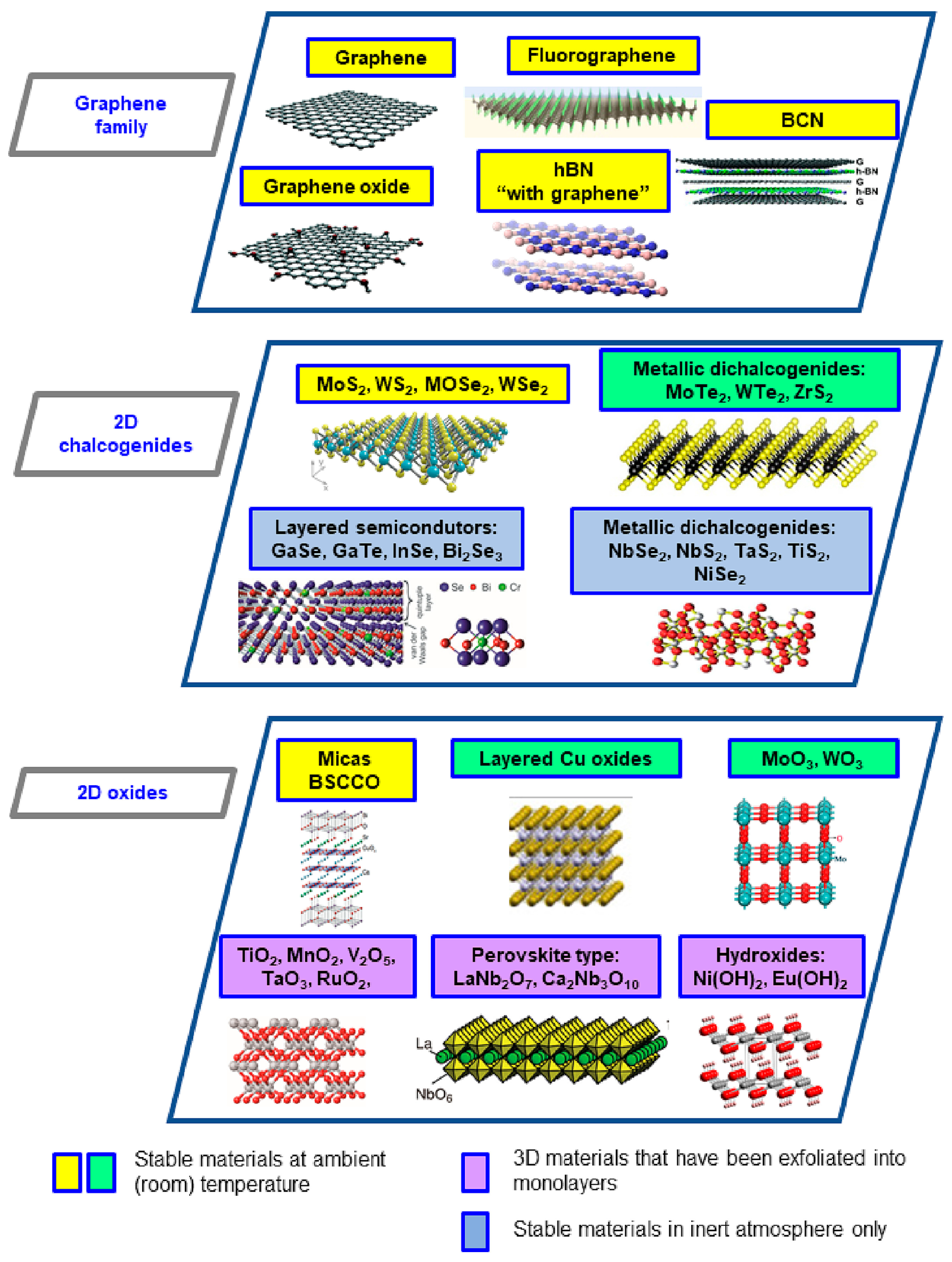
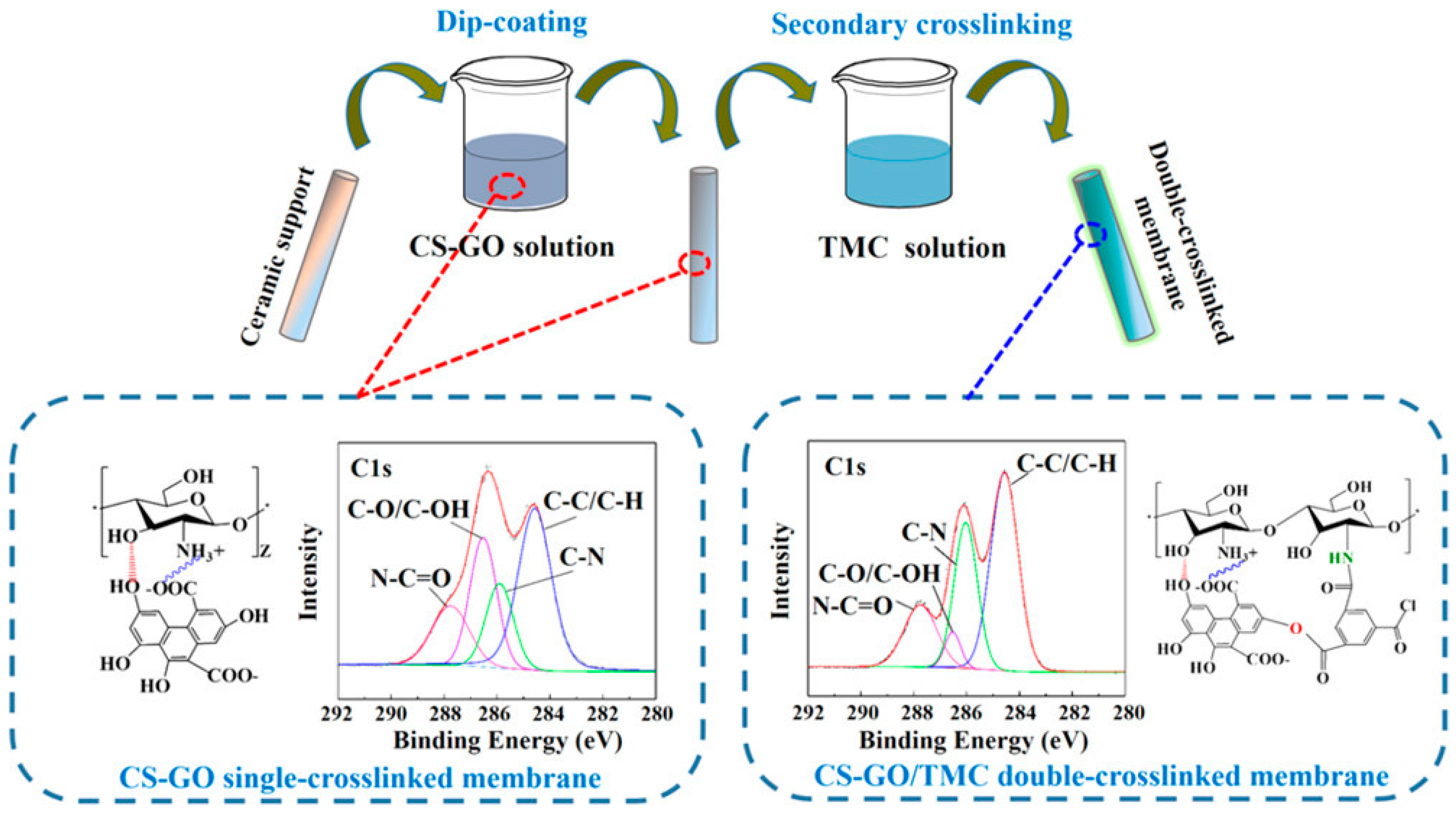
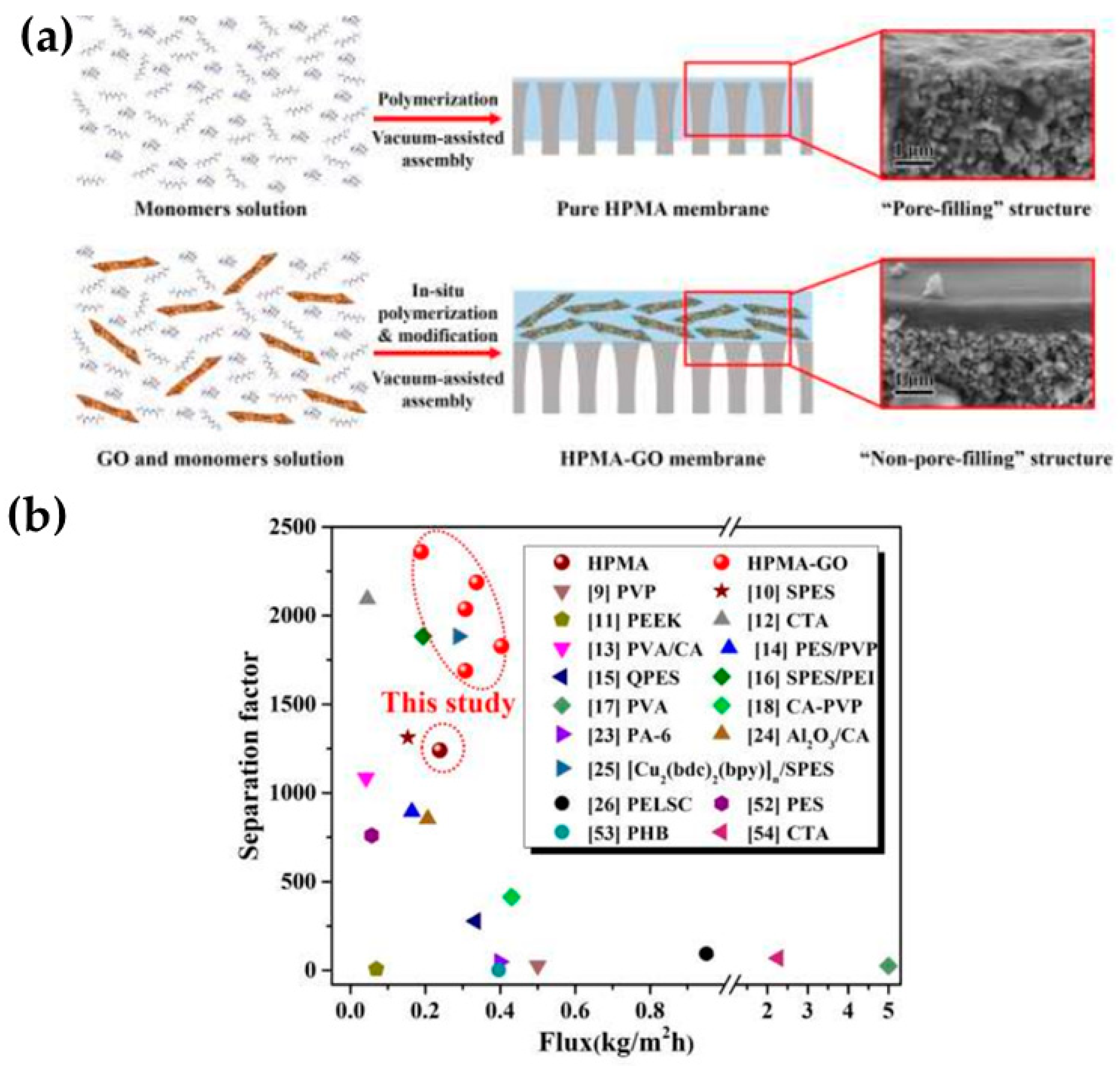
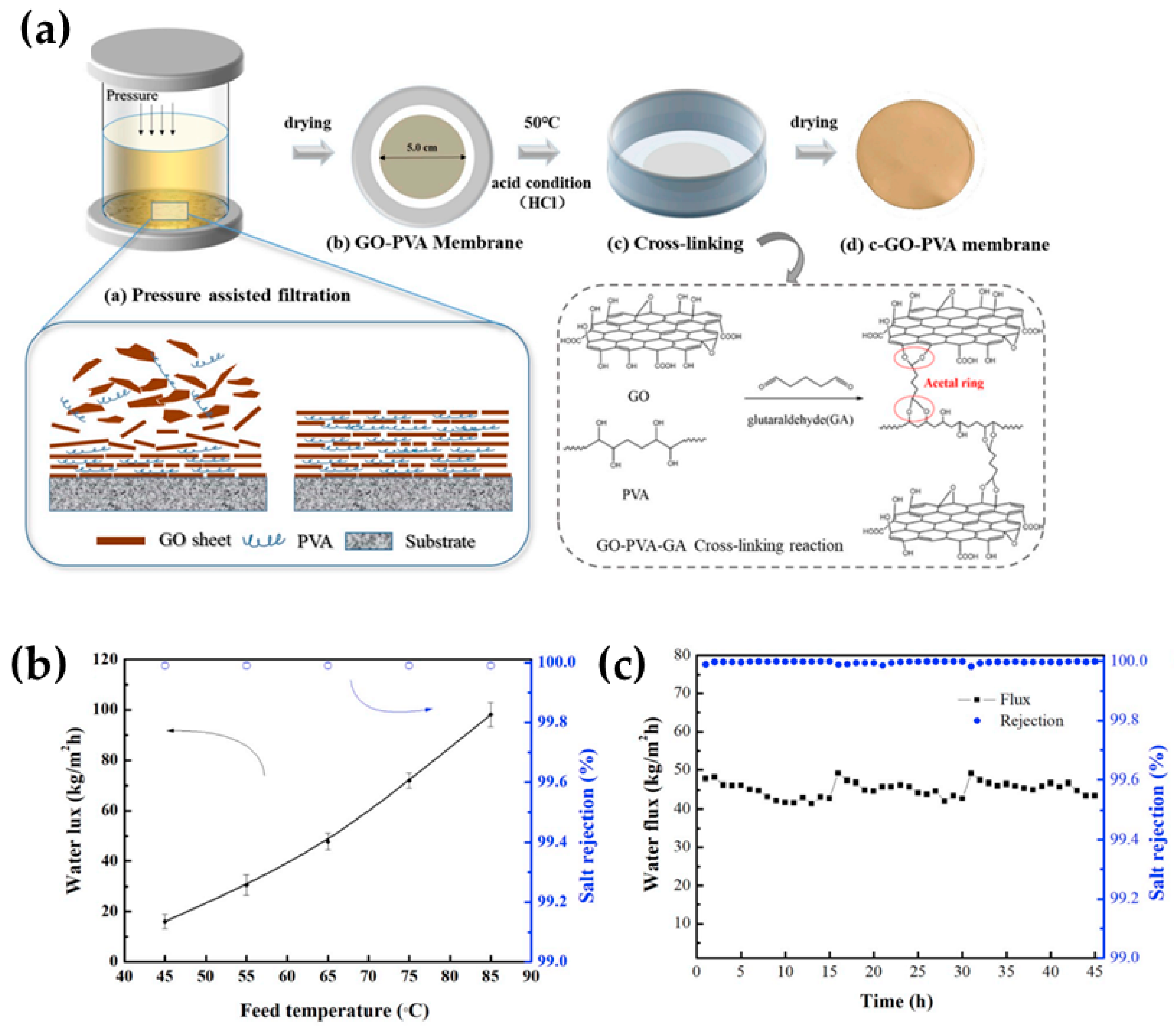
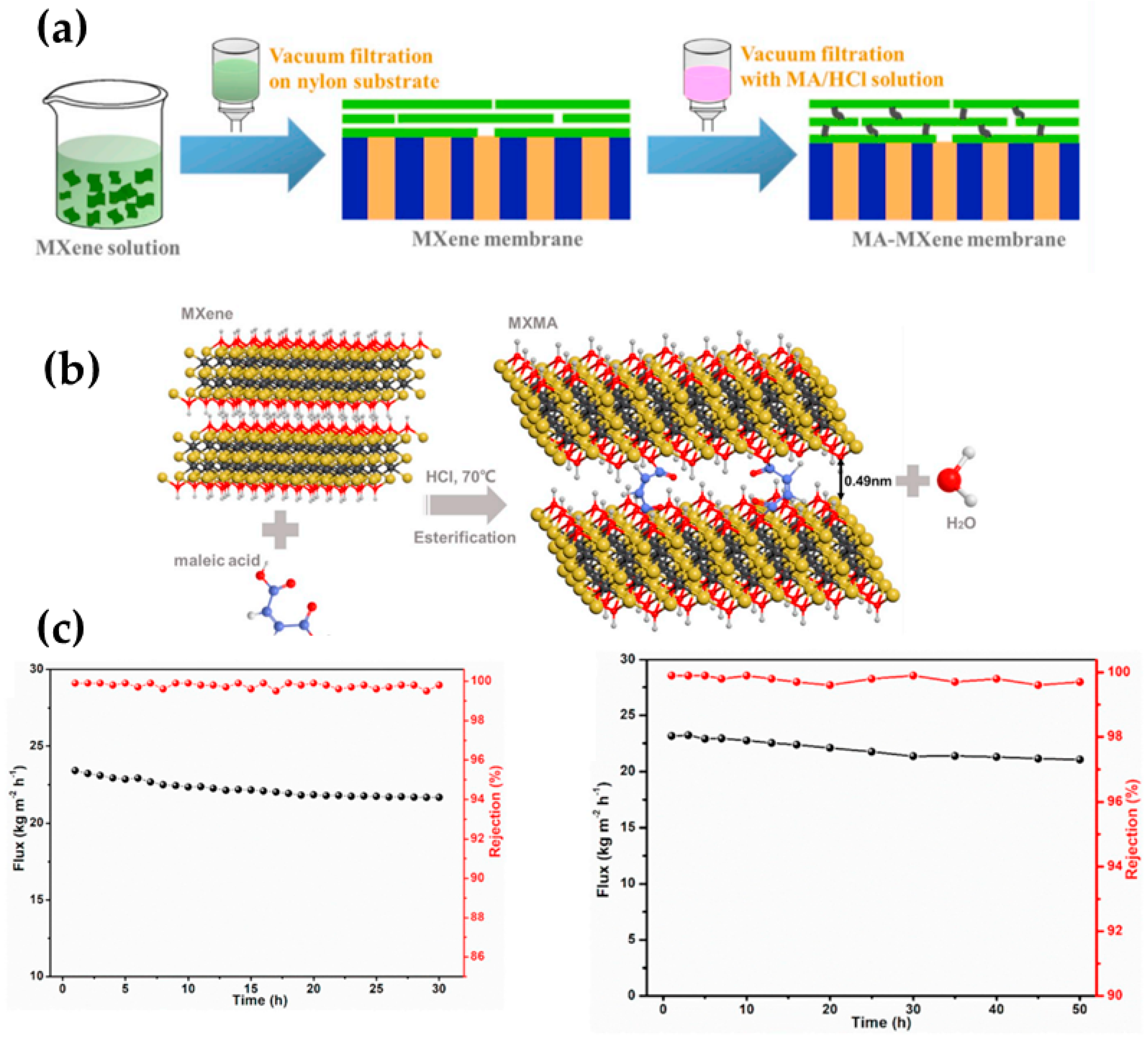
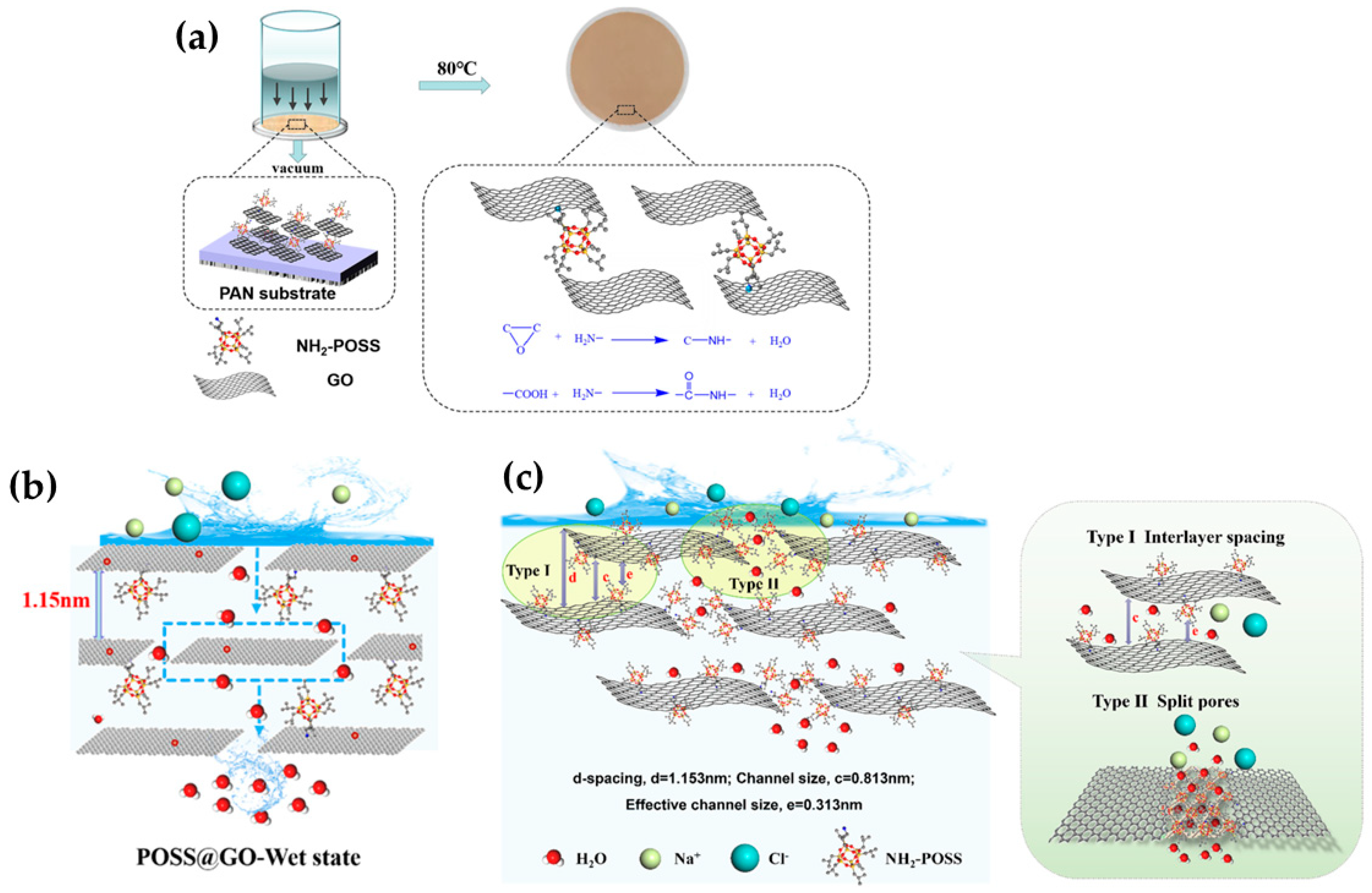
| 2D Material | Estimated Pore Size | Interlayer Spacing | Nature | Separation Mechanism |
|---|---|---|---|---|
| MXene | 19.5 nm | <2 Å | Hydrophilic | Size sieving effect |
| Fluorographene | 0.2–0.9 nm | 6.2 Å | Hydrophobic | Size sieving effect/ molecular interaction |
| Graphene | ~0.2 nm | ~1.42 Å | Hydrophobic | Size sieving effect |
| Graphene oxide | <0.3 nm | 5–9 Å | Hydrophilic | Size sieving effect |
| MoS2 | 2.8 nm | 0.615 nm | Hydrophobic | Electrostatic interactions |
| g-C3N4 | ~3 nm | 3–6 Å | Hydrophilic | Size sieving effect/ electrostatic interactions |
| h-BN | ~3.1 nm | 3.34 Å | Hydrophobic | Size sieving effect |
| Composite Membrane | Temperature (°C) | Water Concentration (wt.%) | Total Flux (kg∙m−2h−1) | Separation Factor | Reference |
|---|---|---|---|---|---|
| Water/ethyl acetate mixtures | |||||
| MXene/CS | 50 | 2 | 1.471 | 4898 | [29] |
| UiO-66@ graphene oxide | 50 | 2 | 3.233 | 6951 | [30] |
| Perfluorosulfonic acid-TEOS | 40 | 2 | 0.205 | 496 | [31] |
| Water/ethanol mixtures | |||||
| MXene/CS | 50 | 10 | 1.424 | 1421 | [29] |
| MOF-801/CS | 70 | 10 | 1.937 | 2156 | [30] |
| Graphene/CS | 30 | 10 | 0.010 | 1093 | [32] |
| Fe3O4/CS | 75 | 10 | 1.024 | 1500 | [33] |
| POSS/CS | 60 | 10 | 0.270 | 30 | [34] |
| Water/dimethyl carbonate mixtures | |||||
| MXene/CS | 50 | 2 | 1.428 | 906 | [29] |
| Graphene oxide | 40 | 2 | 1.400 | 484 | [35] |
| Membrane Type: | Interlayer Spacing (nm) | NaCl Concentration (wt.%) | Operating Temperature (°C) | Permeation (kg∙m−2h−1) | Salt Rejection (%) | Ref. |
|---|---|---|---|---|---|---|
| GO-PVA | 1.23 | 10 | 85 | 98 | 99.99 | [51] |
| GO-PAN | - | 3.5 | 90 | 65.1 | 99.8 | [52] |
| CDA-GO composite | 0.91 | 3.5 | 90 | 20.1 | 99.9 | [53] |
| PDI-GOF | 0.83 | 3.5 | 90 | 11.4 | 99.9 | [54] |
| pPDA-GO composite | 1.13 | 3.5 | 90 | 10.7 | 99.8 | [53] |
| GO-PVA-GA-PAN | - | 3.5 | 70 | 69.1 | 99.9 | [49] |
Disclaimer/Publisher’s Note: The statements, opinions and data contained in all publications are solely those of the individual author(s) and contributor(s) and not of MDPI and/or the editor(s). MDPI and/or the editor(s) disclaim responsibility for any injury to people or property resulting from any ideas, methods, instructions or products referred to in the content. |
© 2024 by the author. Licensee MDPI, Basel, Switzerland. This article is an open access article distributed under the terms and conditions of the Creative Commons Attribution (CC BY) license (https://creativecommons.org/licenses/by/4.0/).
Share and Cite
Castro-Muñoz, R. Composite 2D Material-Based Pervaporation Membranes for Liquid Separation: A Review. Molecules 2024, 29, 2829. https://doi.org/10.3390/molecules29122829
Castro-Muñoz R. Composite 2D Material-Based Pervaporation Membranes for Liquid Separation: A Review. Molecules. 2024; 29(12):2829. https://doi.org/10.3390/molecules29122829
Chicago/Turabian StyleCastro-Muñoz, Roberto. 2024. "Composite 2D Material-Based Pervaporation Membranes for Liquid Separation: A Review" Molecules 29, no. 12: 2829. https://doi.org/10.3390/molecules29122829





